Pentax AF-360FGZ User Manual
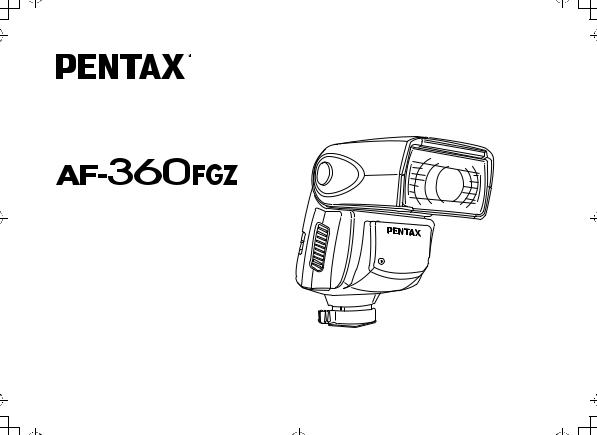
AUTO ZOOM ELECTRONIC FLASH UNIT
OPERATING MANUAL
Please read this operating manual carefully first for proper use.

Thank you for purchasing the PENTAX Auto-flash AF360FGZ.
In addition to easy daylight sync photography with TTL auto, the AF360FGZ also allows wireless TTL auto (P-TTL auto) photography and high-speed sync. It is clip-on type flash which enables accurate focus adjustments even in dark locations with built-in AF-assist spotbeam.
Bundled Items
The following items are supplied with this product.
Check that all the items have been included before use.
•Case
•Operating manual (this manual)
•Certification
PENTAX is a trademark of PENTAX Corporation.

FOR SAFE USE OF YOUR FLASH UNIT
Although we have carefully produced this flash unit for safe operation, please be sure to especially follow warnings and cautions given on page 2.
 WARNING
WARNING
This mark indicates precautions that, if not followed, could result in serious injury to the user.
 CAUTION
CAUTION
This mark indicates precautions that, if not followed, could result in minor or medium injury to the user or damage to the equipment.
is a symbol indicating items that are prohibited.
is a symbol emphasizing a warning.
1

 WARNING
WARNING
The flash contains electronic circuits that operate at high voltages. Do not attempt to disassemble the flash unit yourself, as there is danger of an electric shock.
If internal parts of the flash unit becomes exposed due to impact, etc., do not touch them as there is danger of an electric shock.
Do not expose the flash unit to water or moisture as there is danger of an electric shock.
 CAUTION
CAUTION
Do not use the flash near anyone’s eyes, as it may hurt them. Be particularly careful with the flash around infants.
The following may lead to an explosion or fire.
•Shorting the batteries
•Exposing the batteries to flames
•Dismantling the batteries
•Attempting to recharge non-rechargeable batteries
Remove the batteries from the camera immediately if they become hot or begin to smoke. Be careful not to burn yourself during removal.
2

Precautions for Your Flash Unit
•Never use organic solvents such as paint thinner, alcohol or benzene to clean the flash unit.
•Avoid leaving the flash unit for extend period in places where the humidity and temperature are very high such as in a car.
•Be careful not to subject the flash unit to strong vibrations, shock or pressure. Use a cushion to protect the flash unit when carrying it in a motorcycle, car, boat, etc.
•Do not use the flash unit where it may be directly exposed to rain water etc.
•When using the flash unit off the camera, do not try to attach any metallic object to the electric contacts or to mount incompatible accessories. Otherwise, the TTL auto mechanism may be damaged or rendered inoperable.
•Periodic checks are recommended every 1 to 2 years in order to maintain high performance. If the unit has not been used for an extended period of time, or is being readied for an important shoot, it is recommended that you take a test flash with the test button and test shoot with it. Test flash is also important to maintain optimum performance.
•Avoid contact with garbage, dirt, sand, dust, water, toxic gases, salt, etc. When the flash unit is subjected to rain or moisture, wipe it off with a dry soft.
•When photographing black subjects or white subjects, use exposure compensation.
•Do not attach any accessories having the wrong number of electrical contacts for the hot shoe or grip. Otherwise, some functions may not work properly.
•Pentax will not be held responsible for any accidents or damage, etc. caused due to the use of this product with cameras which are made by companies other than Pentax.
3

nCautions Regarding Batteries
•This flash unit uses 4 AA-size alkaline, lithium, or nickel metal hydride batteries. Do not use any other type of batteries. The flash unit may not be able to operate correctly or demonstrate sufficient performance, or the flash unit itself may generate heat, depending on the type of batteries used.
•AA-size alkaline and lithium batteries themselves are not rechargeable. Also, do not dismantle the batteries. Trying to recharge or dismantle these batteries may cause an explosion or leakage.
•When changing batteries, do not mix batteries of different manufacturers, type and capacity.
•Do not insert the batteries with the positive (+) and negative (-) terminals the wrong way around. Incorrect insertion may lead to an explosion or fire.
•Battery performance may temporarily be hindered in low temperatures. Batteries should be kept warm in temperatures below freezing for proper performance.
•If you do not intend to use the flash unit for an extended period of time, remove the batteries. Leaving the batteries in may cause damage to the flash unit due to leakage etc.
4

Table of Contents |
|
FOR SAFE USE OF YOUR FLASH UNIT |
........... 1 |
Precautions for Your Flash Unit ....................... |
3 |
Cautions Regarding Batteries............................. |
4 |
Names of Parts ................................................... |
6 |
LCD Panel Indicator............................................ |
8 |
Inserting the Batteries ..................................... |
10 |
Mounting to Camera......................................... |
12 |
Turning the Power On...................................... |
13 |
Auto Power Off Function................................... |
14 |
Quick Power On Function................................. |
14 |
Select Button (S)/Adjustment |
|
Dial Functions............................................... |
15 |
Camera Format and Flash |
|
Coverage Angle ............................................ |
17 |
Using the Flash Modes .................................... |
22 |
P-TTL Auto Flash.............................................. |
23 |
TTL Auto Flash ................................................. |
24 |
Auto Flash......................................................... |
25 |
Manual Flash .................................................... |
27 |
Using the Sync Mode....................................... |
29 |
Leading Curtain Sync Mode ............................. |
30 |
Trailing Curtain Sync Mode .............................. |
30 |
High-Speed Sync Mode.................................... |
31 |
Contrast Control Sync Flash............................. |
33 |
Advanced Functions ........................................ |
35 |
Wireless Mode .................................................. |
35 |
Slave................................................................. |
47 |
Slave Mode Setting........................................... |
49 |
Slow-Speed-Sync Photography........................ |
50 |
Bounce Flash.................................................... |
51 |
AF Spotbeam.................................................... |
53 |
Wide-Angle Panel and Catchlight Panel........... |
54 |
Modeling Flash/Test Flash................................ |
55 |
Connecting the AF360FGZ with the |
|
Extension Cord ............................................. |
56 |
Supported Functions for Pentax Cameras .... |
57 |
Cameras that Support Each Flash Mode.......... |
57 |
Cameras that Support Each Sync Mode .......... |
59 |
Cameras that Support Wireless Mode.............. |
60 |
Cameras that Support Slow-Speed-Sync |
|
Mode............................................................. |
61 |
Functions Related to Each Flash Mode............ |
61 |
Sync Mode Restrictions .................................... |
69 |
Precautions When Photographing with a |
|
Slave Flash ................................................... |
76 |
Flash Effective Range ...................................... |
77 |
Calculating the Flash Effective Range.............. |
77 |
Guide Number (GN).......................................... |
79 |
P-TTL and TTL Auto Flash Effective Range..... |
82 |
Optional Accessories....................................... |
84 |
Specifications ................................................... |
85 |
Warranty Policy ................................................ |
88 |
5

Names of Parts
Bounce angle adjustment |
Bounce lock release button |
LCD panel |
Battery chamber cover |
Flash mode button |
Shoe lock pin |
Select button |
Flash signal contacts |
Adjustment dial |
Shoe bracket |
LCD panel illumination button/ Format button |
Locking lever |
Zoom button/ Channel button |
Wide-angle panel |
Test button/ Modeling button/ Ready lamp |
Catchlight panel |
Setting switch |
AF spotbeam emitter |
Power switch |
Auto flash sensor |
Wireless mode switch |
Flash head |
Sync mode switch |
Wireless sensor |
6
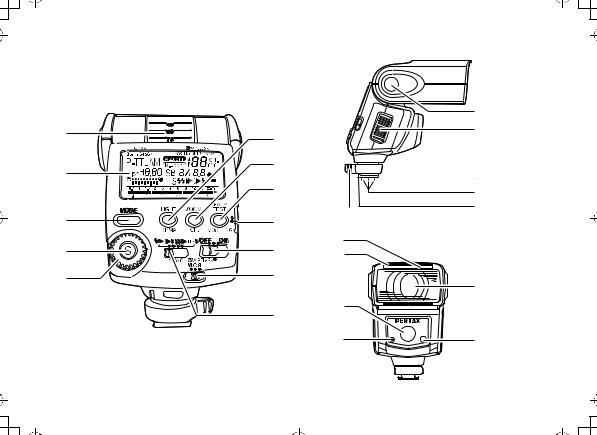
|
|
|
|
|
|
|
|
|
|
||
|
|
|
|
|
|
|
|
|
|
|
|
|
|
|
|
|
|
|
|
|
|
|
|
|
|
|
|
|
|
||
|
|
|
|
|
|
||
|
|
|
|
|
|
|
|
|
|
|
|
|
|
|
|
|
|
|
|
|
|
|
|
7
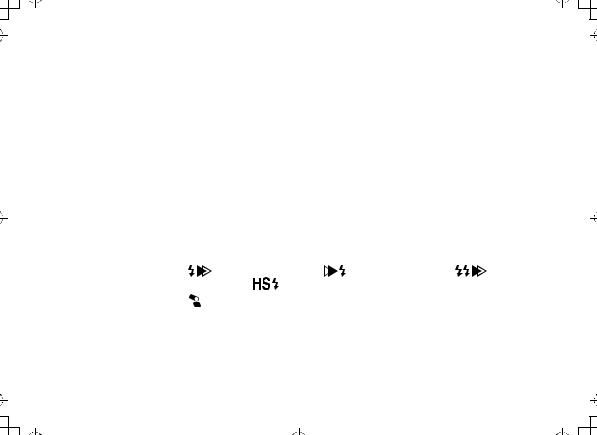
nLCD Panel Indicator
Zoom indicator |
: A.Zoom Ý M.Zoom xxmm = 20, 24, 28, 35, 50, 70, 85 (35 mm format) |
||||
|
|
|
35, 45, 55, 70, 100, 135, 150 (645 format) |
||
|
|
|
55, 60, 70, 90, 120, 180, 190 (67 format) |
||
|
|
|
13, 16, 19, 24, 34, 48, 58 (Digital camera) |
||
Format indicator |
: 35mm Ý 645 Ý 67 |
|
|
|
|
Flash mode indicator |
: P-TTL Ý A Ý M Ý SB |
|
|
||
Flash exposure |
: -3.0 to +1.0 steps, 0.5 step increments |
|
|||
compensation indicator |
|
|
|
|
|
ISO indicator |
: ISO 25 to 1600 |
|
|
|
|
Bar graph |
|
|
|
|
|
Effective flash range |
: Minimum distance - Maximum distance (in P-TTL, TTL, A modes) |
|
|||
indicator |
|
Minimum distance (in manual mode) |
|
|
|
AF spotbeam |
: SB |
|
|
|
|
Sync mode indicator |
: |
(Leading curtain sync) - |
(Trailing curtain sync) - |
(Contrast |
|
|
|
control sync) - |
(High-speed sync) |
|
|
Bounce flash warning |
: |
|
|
|
|
Flash output adjustment |
: NN/ X X |
|
|
|
|
indicator |
|
|
|
|
|
f/stop |
: |
F2 to F22 (When set to ISO 100) |
|
|
|
Channel indicator |
: |
1 to 4CH |
|
|
|
Wireless mode indicator |
: |
MASTER, CONTROL, SLAVE |
|
|
|
8
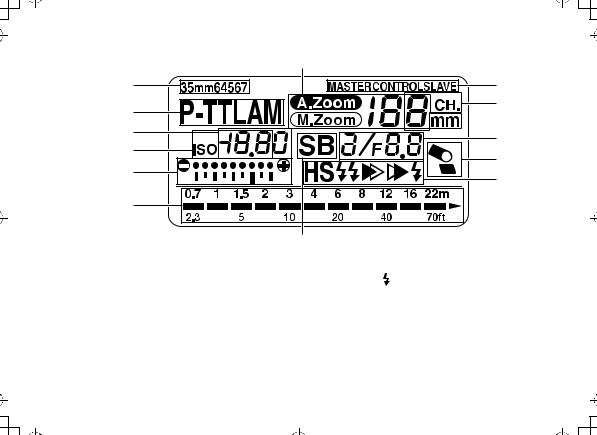
|
|
|
|
|
|
|
|
|
|
|
|
|
|
|
|
|
|
|
|
|
|
|
|
When in poorly lit locations and the LCD panel cannot be seen, pressing the LCD panel illumination button (LIGHT) will illuminate the panel for about 10 seconds. Pressing it again will turn off the illumination.
•The camera's LCD panel lights up also when you press the LCD illumination button (LIGHT) and the exposure metering timer is on for the following camera.
MZ-S
Auto Check Display
If the correct flash output is obtained, the flash mode indicator and ( ) in the viewfinder will begin blinking. If the auto check display does not blink, the flash output is insufficient. Verify the effective flash range (refer to page 77) and adjust the distance to the subject, or open the aperture further.
Even if the auto check display is blinking, the flash output may be incorrect if the subject is too close. • Depending on the combination of flash mode and camera, the auto check display may not
display correctly
9
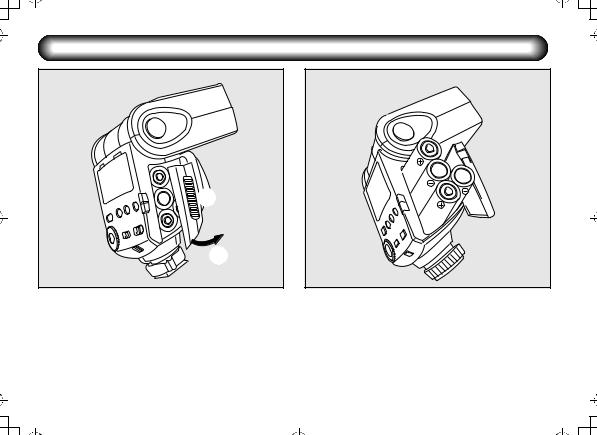
Inserting the Batteries

1 Slide the battery chamber cover as shown in the figure to open.
2 Insert four AA-size batteries, making sure the plus/minus marking (+, -) match the diagram inside the battery chamber cover.
10

Types of Batteries
This flash unit uses four AA-size batteries of the same type, as shown below.
-Alkaline battery (LR6)
-Lithium battery (FR6)
-Nickel-Metal Hydride battery (Ni-MH)
(Nickel manganese (Ni-Mn) and nickel cadmium (Ni-
Cd) batteries cannot be used.)
•For information about recycling times and total number of flashes, refer to “Specifications” on page 85.
•If the indicators on the LCD panel or the ready lamp does not light up, the batteries may be exhausted or not inserted correctly. Verify the orientation of the batteries or, if the indicators and ready lamp still do not light up, replace them with new batteries.
•If you let the flash unit fire successively using lithium batteries, the batteries will overheat, activating a safety circuit that temporarily disables the flash unit. If this occurs, rest the flash unit so that the temperature of the batteries returns to normal.
11
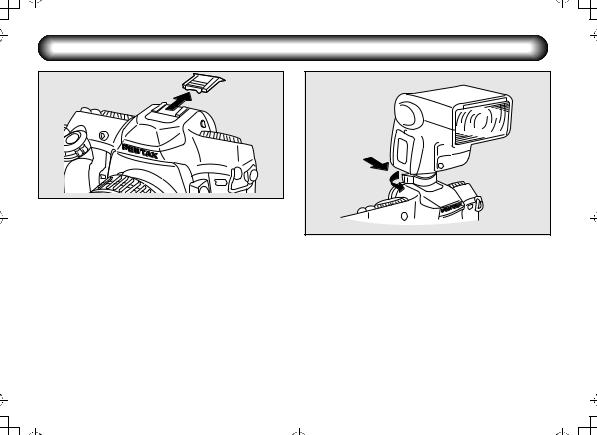
Mounting to Camera
1
1 Remove the hot shoe cover from the camera.
2 Attach the flash unit to the camera.
Turn the locking lever of the flash unit in the direction opposite to that indicated by (FIXÝ) (clockwise from the direction of the LCD
panel).
Slide the hot shoe bracket of the flash unit into the camera's hot shoe from the back of the
camera forward.
Turn the locking lever of the flash unit in the direction indicated by (FIXÝ) to lock it.
2
lThe following cameras have a shoe lock pin. When attaching the flash unit, turn the locking lever in the (FIXÝ) direction and lock the flash unit to the camera with the shoe lock pin. When releasing the flash unit, be sure to do so after turning the locking lever in the direction opposite to that indicated by (FIXÝ) and loosening the shoe lock pin. Otherwise, the hot shoe will be damaged. *ist D series, *ist, MZ-S, MZ-L/ZX-L/MZ-6, MZ-60/ZX-60
lThe 672 does not come with a hot shoe. The optional hot shoe grip 672 should be used.
12
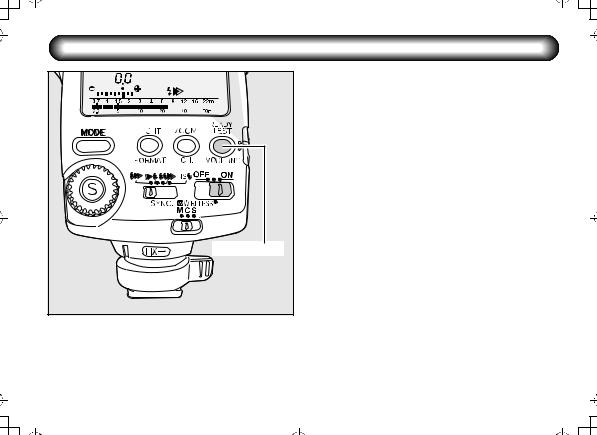
Turning the Power On
œŦŢťźġŭŢŮű |
Sliding the power switch to the (ON) position will turn on the power. The ready lamp will light up when the flash is charged. Sliding it to the (OFF) position will turn off the power.
If charging time takes more than 20 seconds, the batteries have been exhausted and should be replaced with new batteries. If the flash unit is used with exhausted batteries, the settings may return to their default configuration.
lTurn the camera on before turning the flash unit on.
lThe WIRELESS position of the power switch is used for wireless mode and slave flash lighting. For details, see the explanations for each function.
ÝWireless mode (Page 35 - 46)
ÝSlave flash (Page 47 - 48)
13

nAuto Power Off Function
When the flash unit is left unused for about 3 minutes with the power switch set to the (ON) position, it automatically turns off to save the power.
•In the auto flash mode (A), the power will turn off after about 6 minutes.
•In the wireless mode, the power will turn off after about 1 hour of non-operation.
nQuick Power On Function
If the flash unit is mounted on the autofocus cameras, press the shutter release button half way to turn on the power.
14

Select Button (S)/Adjustment Dial Functions
4 types of settings are available as shown on the following pages for the select button (S) and the adjustment dial.











Procedure |
Turn the adjustment dial and adjust the blinking |
Press the select button (S) so that the number to |
2 number. |
1 adjust blinks. |
|
15
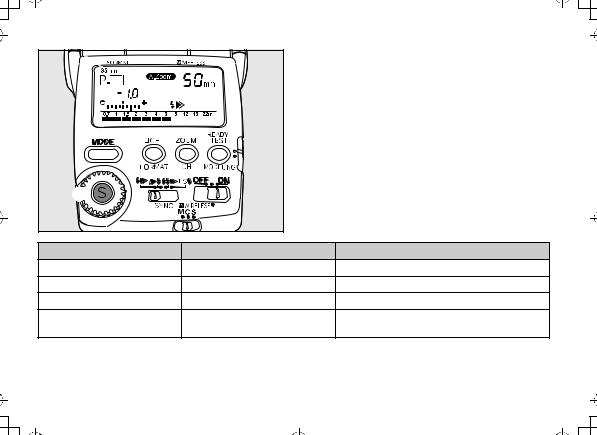
|
|
After adjustment, press the select button (S) and |
|
|
3 stop the blinking. Adjust the other items below |
||
|
|
using the same procedure. |
|
|
• When using multiple flash units set to P-TTL or |
||
|
TTL Auto and adjusting the amount of light at the |
||
|
same time, use the camera’s exposure |
||
|
compensation. |
||
|
|
|
|
|
Connected Flash Mode |
Adjustment Range |
|
Flash exposure compensation |
P-TTL Auto flash |
-3.0 to +1.0 levels (EV) (0.5 step increments) |
|
ISO / F (aperture) setting |
Auto flash (A) |
ISO 25 to ISO 1600, F2 to F22 (with ISO100) |
|
Manual flash output |
Manual (M) |
1/1, 1/2, 1/4, 1/8, 1/16, 1/32 |
|
Flash output setting |
Wireless (W) master flash (M) |
1/1, 2/3, 1/2, 1/3 |
|
Wireless (W) slave flash (S) |
|||
|
|
||
16
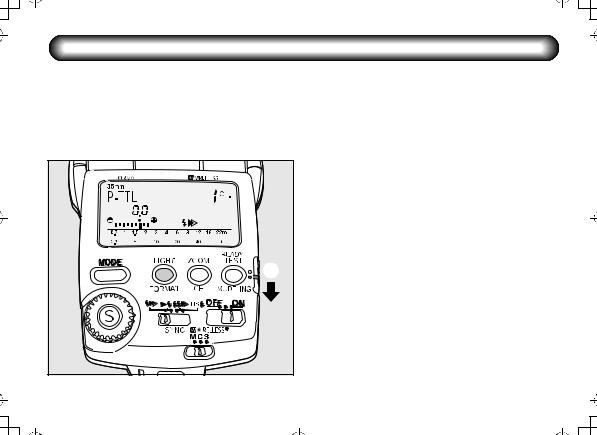
Camera Format and Flash Coverage Angle
The AF360FGZ’s flash coverage angle can be adjusted to match the angle of view of the lens being used, which enables effective distribution of the flash light. The flash coverage angle is indicated by the focal lengths of available lenses in the LCD panel of the flash unit, according to the preset image size (FORMAT) of the camera.
|
|
|
1 Format setting
Firstly, set the FORMAT to match the image size of the camera you are using.
The format size will automatically be set when the shutter release button is pressed halfway down when the AF360FGZ is used in combination with the following cameras. *ist, MZ-S, MZ-L/ZX-L/MZ-6, *ist DL2, *ist DS2, *ist DL, *ist DS, *ist D
For other cameras, before use, set the FORMAT to match the image size of the camera according to the following procedure.
Slide the setting switch down (yellow dot).
Press the FORMAT button repeatedly to display camera formats (image sizes) in the LCD panel.
You can switch from 35mm Ý 645 Ý 67 Ý 35mm in that order.
17
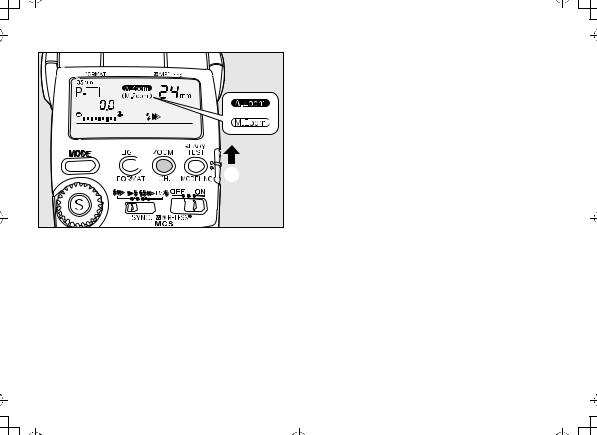
|
|
2 Zoom position (Flash coverage angle) setting |
Next, set the zoom (flash coverage angle) to match the focal length of the lens you are using.
Auto Zoom (A.Zoom)
If both the camera and lens are autofocus, you can automatically set the flash coverage angle according to the focal length of the lens by pressing the shutter release button of the camera halfway down.
The auto zoom function operates while the exposure meter is operating (while information is being displayed in the viewfinder).
If you are setting the format manually, return the setting switch to the upper (white dot)
position.
When (M.Zoom) is displayed on the LCD panel, press the zoom button (ZOOM) repeatedly until (A.Zoom) is displayed.
•When the flash mode is set to auto flash, the auto zoom function does not operate even if the camera and lens are both autofocus. Set the zoom manually to match the lens angle of view.
Manual Zoom (M.Zoom)
If one or both of the camera and lens are manual focus, you must set the flash coverage angle manually.
If you are setting the format manually, return the setting switch to the upper (white dot)
position.
Press the zoom button (ZOOM) until the focal length of the lens being used is displayed on the LCD panel or if it can not be displayed exactly one wider than the lens focal length. The zoom position is switched in the order shown in the diagram on page 20.
18

Zoom Positions by Camera format
* With the wide-angle panel
35mm camera |
645 camera |
67 camera |
Digital camera |
20mm* |
35mm* |
55mm* |
13mm* |
|
|
|
|
24mm |
45mm |
60mm |
16mm |
|
|
|
|
28mm |
55mm |
70mm |
19mm |
|
|
|
|
35mm |
70mm |
90mm |
24mm |
|
|
|
|
50mm |
100mm |
120mm |
34mm |
|
|
|
|
70mm |
135mm |
180mm |
48mm |
|
|
|
|
85mm |
150mm |
190mm |
58mm |
|
|
|
|
•When the wide-angle panel is used, the zoom button (ZOOM) will not work. (The wide-angle panel is in a slit on the top of the flash head. Pull it out so that it covers the front of the flash head. If the catchlight panel is not necessary, leave it in the slit.)
19
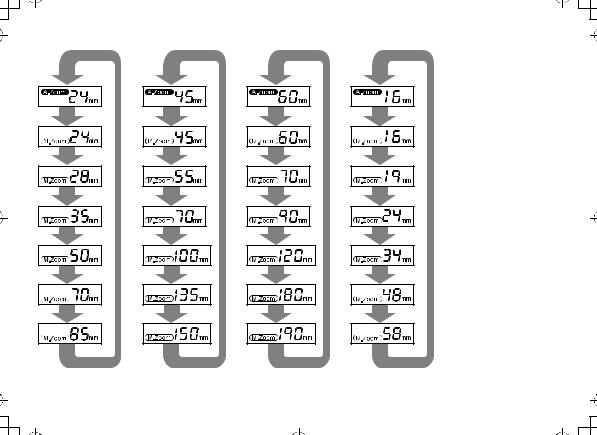
35mm Camera |
645 Camera |
67 Camera |
Digital Camera |
20

•In the (A.Zoom) mode, the flash coverage angle will be adjusted automatically to suit the lens focal length when you press the shutter release button halfway, and the camera exposure metering timer is on.
•A warning signal appears as follows when the flash cannot cover the focal length of the camera.
-The zoom indicator blinks for the combination of the following camera and lenses.
Camera |
Lens Types |
|
*ist D series |
DA, D FA, FA J, FA, F |
|
|
|
|
35mm autofocus single |
D FA, FA J, FA, F |
|
lens reflex cameras |
||
|
||
|
|
|
645N2, 645N |
FA645 |
|
|
|
-The warning signal does not appear for the combination of the following cameras and focal lengths.
Camera |
Focal length |
|
*ist, MZ-L/ZX-L/MZ-6, |
20 mm and over, less |
|
MZ-S |
than 24 mm |
|
*ist DL, *ist DS, *ist D |
13 mm and over, less |
|
than 16 mm |
||
|
•In the (A.Zoom) mode, if there is no lens focal length information, the flash coverage angle will be set automatically to 24mm with a 35mm camera and digital camera. With a 645 camera, it will be set to 45mm, with a 67 camera it will be 60mm.
•When using the wide-angle panel, the angle will be fixed at 20 mm for a 35 mm camera, 35 mm for a 645 camera, 55 mm for a 67 camera, and 13 mm for a digital camera in both A.Zoom and M.Zoom.
21

Using the Flash Modes
The AF360FGZ has the following flash modes. Select the mode best suited for the subject.
Before photographing, confirm the following.
1.Whether your camera supports the desired flash mode.
ÝCameras that Support Each Flash Mode (Page 57)
2.Whether you can use the desired function with the combination of your camera and the flash mode you have set.
ÝFunctions Related to Each Flash Mode (Page 61 - 68)
P-TTL auto flash (P-TTL)
A pre-flash is fired before the main flash so that the multi-segment metering sensor can measure the subject's distance, brightness, brightness difference, backlit condition, etc. The data obtained is incorporated to set the output of the main flash. This mode obtains more accurate results than with the conventional TTL mode. Refer to page 23 for instructions on how to use this flash mode.
TTL auto flash (TTL)
Based on the amount of light reflected off the film of the camera, the camera adjusts the flash output automatically to obtain a correct exposure. Refer to page 24 for instructions on how to use this flash mode.
Auto flash (A)
The built-in flash metering sensor adjusts the flash output automatically. Use with cameras that are not P- TTL or TTL Auto flash compatible. Refer to page 25 for instructions on how to use this flash mode.
Manual flash (M)
When the camera is set to manual exposure, manual flash can be set to suit the subject distance and aperture. The manual flash output can be set to 1/1, 1/2, 1/4, 1/8, 1/16, or 1/32. Refer to page 27 for instructions on how to use this flash mode.
22
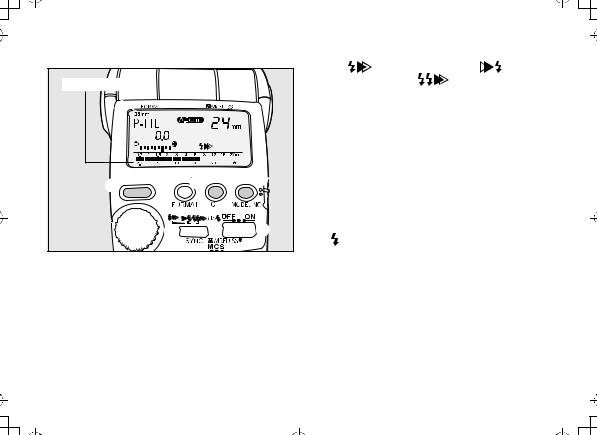
nP-TTL Auto Flash
EffectiveFlash range















Refer to page 22 for the features and conditions of use of this flash mode.
Procedure
1 Turn on the flash unit.
2 Press the flash mode button (MODE) until (P-TTL) is displayed on the LCD panel.
3 |
Set the sync mode switch to leading curtain sync |
|||
( |
), trailing curtain sync ( |
), or |
||
|
contrast-control ( |
), according to the |
||
|
subject. (Refer to page 29.) |
|
||
• After turning the power (ON), the setting will be
(P-TTL) and (A.Zoom).
4 Set the zoom position. (The setting method differs according to your camera and lens. Refer to page 18.)
5 Confirm that the subject is within the effective flash range and the ready lamp is lit. Then take a picture.
• In the following cameras, if the correct flash output is obtained, the flash mode indicator and ( ) in the viewfinder will blink.
*ist, MZ-S, MZ-L/ZX-L/MZ-6
For details, refer to “Auto Check Display” on page 9.
•The correct flash output is obtained in P-TTL auto mode only when the flash unit is used with autofocus lenses.
•If necessary, an exposure compensation amount can be set between +1.0 to -3.0 steps in 0.5-step increments. (Refer to page 15.)
23
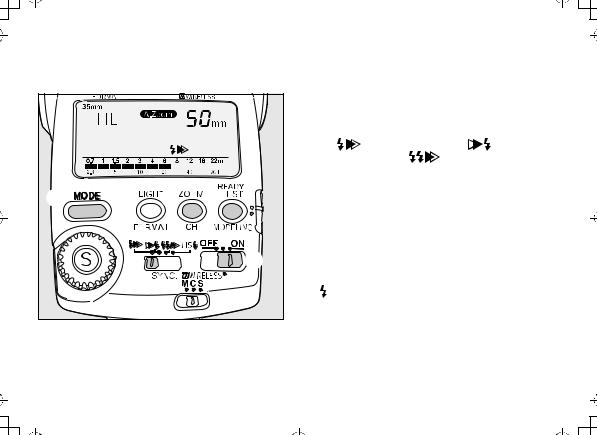
nTTL Auto Flash
Refer to page 22 for the features and conditions of use of this flash mode.
|
|
|
|
|
|
|
|
Procedure
1 Turn on the flash unit.
|
Press the flash mode button (MODE) until (TTL) |
|||
2 is displayed on the LCD panel. |
|
|||
3 |
Set the sync mode switch to leading curtain sync |
|||
( |
), trailing curtain sync ( |
), or |
||
|
contrast-control ( |
), according to the |
||
|
subject. (Refer to page 29.) |
|
||
|
Set the zoom position. (The setting method |
|||
4 differs according to your camera and lens. Refer |
||||
|
to page 18.) |
|
|
|
|
Confirm that the subject is within the effective |
|||
5 flash range and the ready lamp is lit. Then take a |
||||
|
picture. |
|
|
|
• In the following cameras, if the correct flash |
||||
output is obtained, the flash mode indicator and |
||||
( |
) |
in the viewfinder will blink. |
|
|
35 mm single lens reflex cameras except for SF7/ SF10, 672, 645N2, 645N, 645, LX, Super A/
Super Program
For details, refer to “Auto Check Display” on page 9.
24
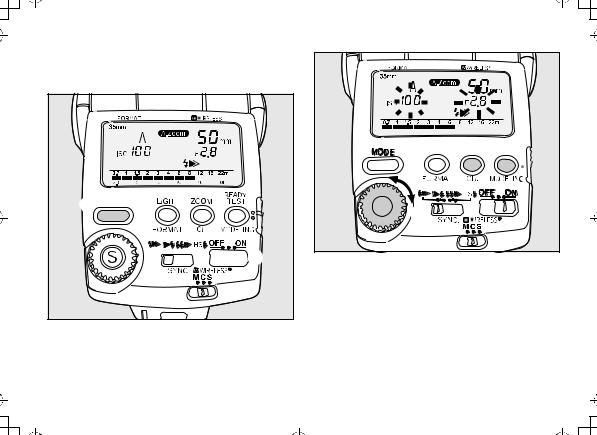
nAuto Flash
Refer to page 22 for the features and conditions of use of this flash mode.




















25

Procedure
1 Turn on the power switch.
2 Press the flash mode button (MODE) until (A) is displayed on the LCD panel.
3 Set the aperture value and ISO.
Press the select button (S) so that (f/stop) on the LCD panel blinks.
Turn the adjustment dial to set the aperture value.
• The effective flash range is displayed on the LCD panel bar graph.
Confirm that the subject is within the effective flash range and press the select button (S).
Turn the adjustment dial to set the ISO after (ISO) starts blinking.
Press the select button (S). The setting is complete if (ISO) stops blinking.
4 Set the lens aperture to the same aperture value as that set on the LCD panel.
•The camera's aperture value is synchronized with that of the flash unit when the camera exposure mode is set to Programmed AE or Shutter Priority AE.
5 Set the zoom position. (The setting method differs according to your camera and lens. Refer to page 18.)
• Select (M.Zoom) regardless of the type of lens being used.
6 Confirm that the subject is within the effective flash range and the ready lamp is lit. Then take a picture.
•In the following cameras, if the correct flash output is obtained, the flash mode indicator and
( ) in the viewfinder will blink.
645, LX, Super A/Super Program, MZ-M/ZX-M, P30T, P30N/P3N, P30/P3, P50/P5, A3Date, A3DateS, Program A/Program Plus
For details, refer to “Auto Check Display” on page 9.
•If the power is turned temporarily OFF, the flash will be set to P-TTL or TTL auto. Return the setting to Auto flash.
•The sync mode will be fixed in leading curtain sync.
26
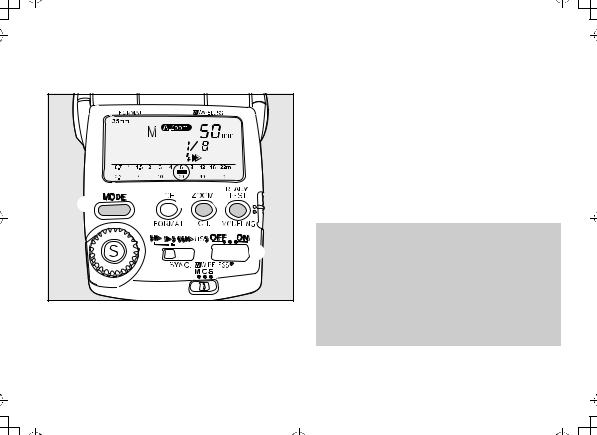
nManual Flash
Refer to page 22 for the features and conditions of use of this flash mode.
|
|





Procedure
1 Turn on the power switch.
2 Press the flash mode button (MODE) to display
(M) (1/xx) on the LCD panel.
• You can set the flash output from 1/1 to 1/32. See page 15.
3 Set the zoom position. (The setting method differs according to your camera and lens. Refer
4 to page 18.)
Example:
If the flash zoom position is 35mm, subject distance (between the AF360FGZ and subject) is 3 m, and sensitivity is ISO 100, the calculation will be as follows:
With flash output (1/1), the Guide No. will be 25 (according to the Guide No. table).
Aperture = Guide No. 25 / Subject distance 3 m = 8.3 
 Approx. 8 (f/Stop)
Approx. 8 (f/Stop)
• Refer to page 79 for the guide number table.
27
